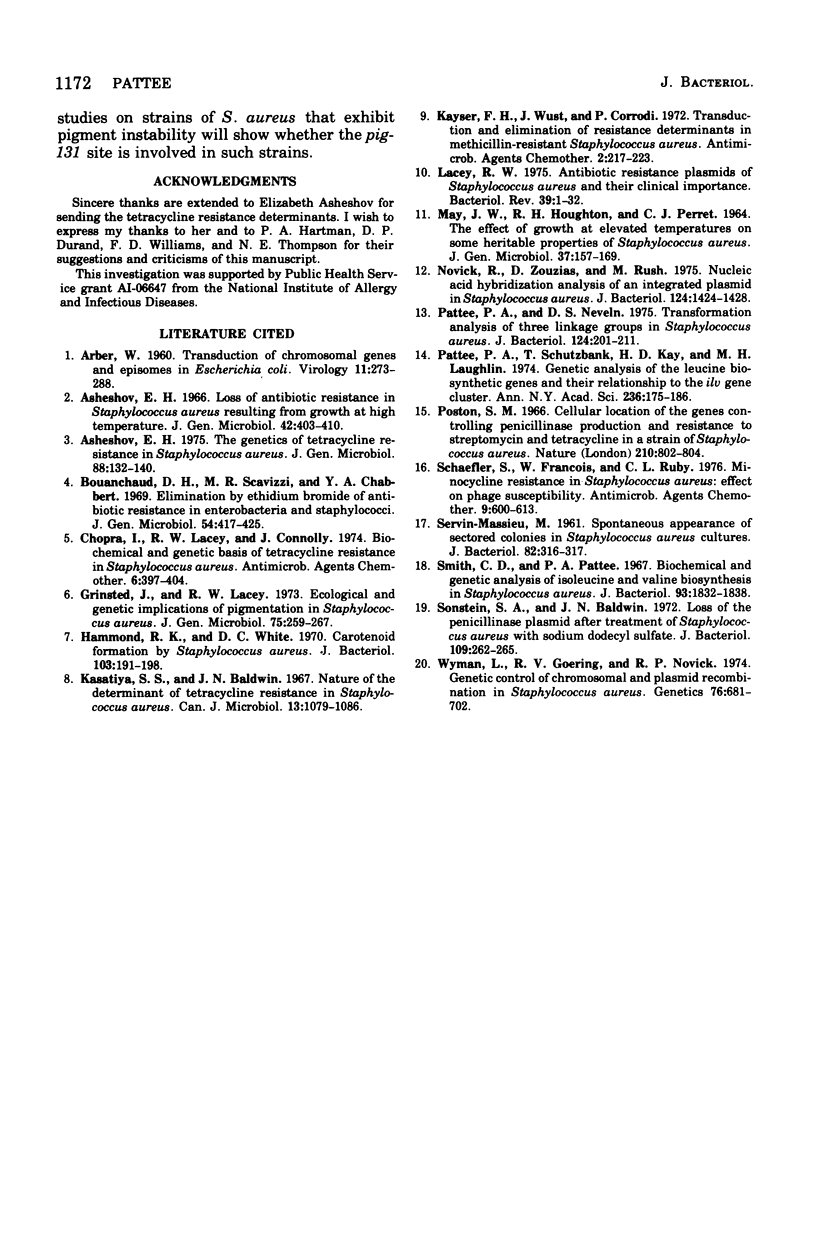Abstract
Three tetracycline resistance determinants (tmn-3106, tmn-3110, and tmn-3511) reported by Asheshov (1975) to be chromosomal in Staphylococcus aureus have been linked by transformation to a purine auxotrophic marker (pur-110), a cluster of eight genes involved in the biosynthesis of isoleucine, valine, and leucine (the ilv-leu region), a marker (ilvR10) that may be involved in the regulation of the ilv-leu region, and a gene involved in pigmentation (pig-131). The linkage group thus defined is tmn-3106-pur-110-ilvR10-(ilv-leu)-pig-131. The orientation of the ilv-leu region relative to ilvR10 and pig-131 was not determined. The tmn-3106, tmn-3110, and tmn-3511 determinants exhibit the same linkage relationships to the other markers. It is concluded that this linkage group represents a portion of the chromosome of S. aureus.
Full text
PDF





Selected References
These references are in PubMed. This may not be the complete list of references from this article.
- ARBER W. Transduction of chromosomal genes and episomes in Escherichia coli. Virology. 1960 May;11:273–288. doi: 10.1016/0042-6822(60)90066-0. [DOI] [PubMed] [Google Scholar]
- Asheshov E. H. Loss of antibiotic resistance in Staphylococcus aureus resulting from growth at high temperature. J Gen Microbiol. 1966 Mar;42(3):403–410. doi: 10.1099/00221287-42-3-403. [DOI] [PubMed] [Google Scholar]
- Asheshov E. H. The genetics of tetracycline resistance in Staphylococcus aureus. J Gen Microbiol. 1975 May;88(1):132–140. doi: 10.1099/00221287-88-1-132. [DOI] [PubMed] [Google Scholar]
- Bouanchaud D. H., Scavizzi M. R., Chabbert Y. A. Elimination by ethidium bromide of antibiotic resistance in enterobacteria and staphylococci. J Gen Microbiol. 1968 Dec;54(3):417–425. doi: 10.1099/00221287-54-3-417. [DOI] [PubMed] [Google Scholar]
- Chopra I., Lacey R. W., Connolly J. Biochemical and genetic basis of tetracycline resistance in Staphylococcus aureus. Antimicrob Agents Chemother. 1974 Oct;6(4):397–404. doi: 10.1128/aac.6.4.397. [DOI] [PMC free article] [PubMed] [Google Scholar]
- Grinsted J., Lacey R. W. Ecological and genetic implications of pigmentation in Staphylococcus aureus. J Gen Microbiol. 1973 Apr;75(2):259–267. doi: 10.1099/00221287-75-2-259. [DOI] [PubMed] [Google Scholar]
- Hammond R. K., White D. C. Carotenoid formation by Staphylococcus aureus. J Bacteriol. 1970 Jul;103(1):191–198. doi: 10.1128/jb.103.1.191-198.1970. [DOI] [PMC free article] [PubMed] [Google Scholar]
- Kasatiya S. S., Baldwin J. N. Nature of the determinant of tetracycline resistance in Staphylococcus aureus. Can J Microbiol. 1967 Aug;13(8):1079–1086. doi: 10.1139/m67-144. [DOI] [PubMed] [Google Scholar]
- Kayser F. H., Wüst J., Corrodi P. Transduction and elimination of resistance determinants in methicillin-resistant Staphylococcus aureus. Antimicrob Agents Chemother. 1972 Sep;2(3):217–223. doi: 10.1128/aac.2.3.217. [DOI] [PMC free article] [PubMed] [Google Scholar]
- Lacey R. W. Antibiotic resistance plasmids of Staphylococcus aureus and their clinical importance. Bacteriol Rev. 1975 Mar;39(1):1–32. doi: 10.1128/br.39.1.1-32.1975. [DOI] [PMC free article] [PubMed] [Google Scholar]
- MAY J. W., HOUGHTON R. H., PERRET C. J. THE EFFECT OF GROWTH AT ELEVATED TEMPERATURES ON SOME HERITABLE PROPERTIES OF STAPHYLOCOCCUS AUREUS. J Gen Microbiol. 1964 Nov;37:157–169. doi: 10.1099/00221287-37-2-157. [DOI] [PubMed] [Google Scholar]
- Novick R., Zouzias D., Rush M. Nucleic acid hybridization analysis of an integrated plasmid in Staphylococcus aureus. J Bacteriol. 1975 Dec;124(3):1424–1428. doi: 10.1128/jb.124.3.1424-1428.1975. [DOI] [PMC free article] [PubMed] [Google Scholar]
- Pattee P. A., Neveln D. S. Transformation analysis of three linkage groups in Staphylococcus aureus. J Bacteriol. 1975 Oct;124(1):201–211. doi: 10.1128/jb.124.1.201-211.1975. [DOI] [PMC free article] [PubMed] [Google Scholar]
- Pattee P. A., Schutzbank T., Kay H. D., Laughlin M. H. Genetic analysis of the leucine biosynthetic genes and their relationship to the ilv gene cluster. Ann N Y Acad Sci. 1974 Jul 31;236(0):175–186. doi: 10.1111/j.1749-6632.1974.tb41490.x. [DOI] [PubMed] [Google Scholar]
- Poston S. M. Cellular location of the genes controlling penicillinase production and resistance to streptomycin and tetracycline in a strain of Staphylococcus aureus. Nature. 1966 May 21;210(5038):802–804. doi: 10.1038/210802a0. [DOI] [PubMed] [Google Scholar]
- SERVIN-MASSIEU M. Spontaneous appearance of sectored colonies in Staphylococcus aureus cultures. J Bacteriol. 1961 Aug;82:316–317. doi: 10.1128/jb.82.2.316-317.1961. [DOI] [PMC free article] [PubMed] [Google Scholar]
- Schaefler S., Francois W., Ruby C. L. Minocycline resistance in Staphylococcus aureus: effect on phage susceptibility. Antimicrob Agents Chemother. 1976 Apr;9(4):600–613. doi: 10.1128/aac.9.4.600. [DOI] [PMC free article] [PubMed] [Google Scholar]
- Smith C. D., Pattee P. A. Biochemical and genetic analysis of isoleucine and valine biosynthesis in Staphylococcus aureus. J Bacteriol. 1967 Jun;93(6):1832–1838. doi: 10.1128/jb.93.6.1832-1838.1967. [DOI] [PMC free article] [PubMed] [Google Scholar]
- Sonstein S. A., Baldwin J. N. Loss of the penicillinase plasmid after treatment of Staphylococcus aureus with sodium dodecyl sulfate. J Bacteriol. 1972 Jan;109(1):262–265. doi: 10.1128/jb.109.1.262-265.1972. [DOI] [PMC free article] [PubMed] [Google Scholar]
- Wyman L., Goering R. V., Novick R. P. Genetic control of chromosomal and plasmid recombination in Staphylococcus aureus. Genetics. 1974 Apr;76(4):681–702. doi: 10.1093/genetics/76.4.681. [DOI] [PMC free article] [PubMed] [Google Scholar]


